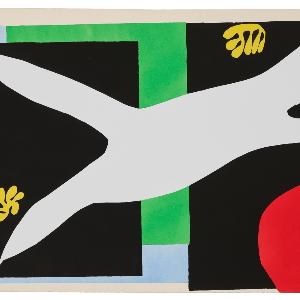
Henri Matisse, Jazz portfolio, 1947, stencil print, La nageuse dans l’aquarium
© VG Bild-Kunst, Bonn 2024, Photo: collecto.art
A panel debate featuring Dr. Cathrin Klingsöhr-Leroy, Dr. Susanne A. Kudielka and Professor Carlos Spoerhase
Speculation has been rife around those works of Henri Matisse that became famous under the heading Jazz and how they came into being. Was it just a publishing project? Was it intended as a sequel to the success story of illustrated books that Picasso had earlier set in motion? Would Matisse himself have prepared the title Cirque? Was the book the artist’s attempt to leave behind the horrors of fascism and occupation? Or were the works, on the contrary, an attempt to come to terms with these events? These and other questions will be debated by a panel consisting of:
- Cathrin Klingsöhr-Leroy, founding Director of the Franz Marc Museum in Kochel and currently President of the Kaldewei Kulturstiftung (Kaldewei Culture Foundation).
- Susanne A. Kudielka, art historian and curator in Basel, Switzerland.
- Carlos Spoerhase, Chair of Modern German Literature at LMU and currently co-spokesman for CAS research into “Scaling”.
The catalogue that goes with the Henri Matisse – Jazz exhibition will be presented at this event.
Since 2008, a series of temporary exhibitions have been held on the premises of the CAS in cooperation with UniGalerieLMU.
Visitors are required to register in advance. For more information, please visit the CAS website.
The Center for Advanced Studies at LMU provides a forum for scientific exchange and discussion that bridges the divide between the established disciplines. Its activities are designed to promote all forms of collaborative research and to stimulate interdisciplinary communication within the University. In addition, it facilitates the integration of visiting scholars and scientists into the academic life of the University.
